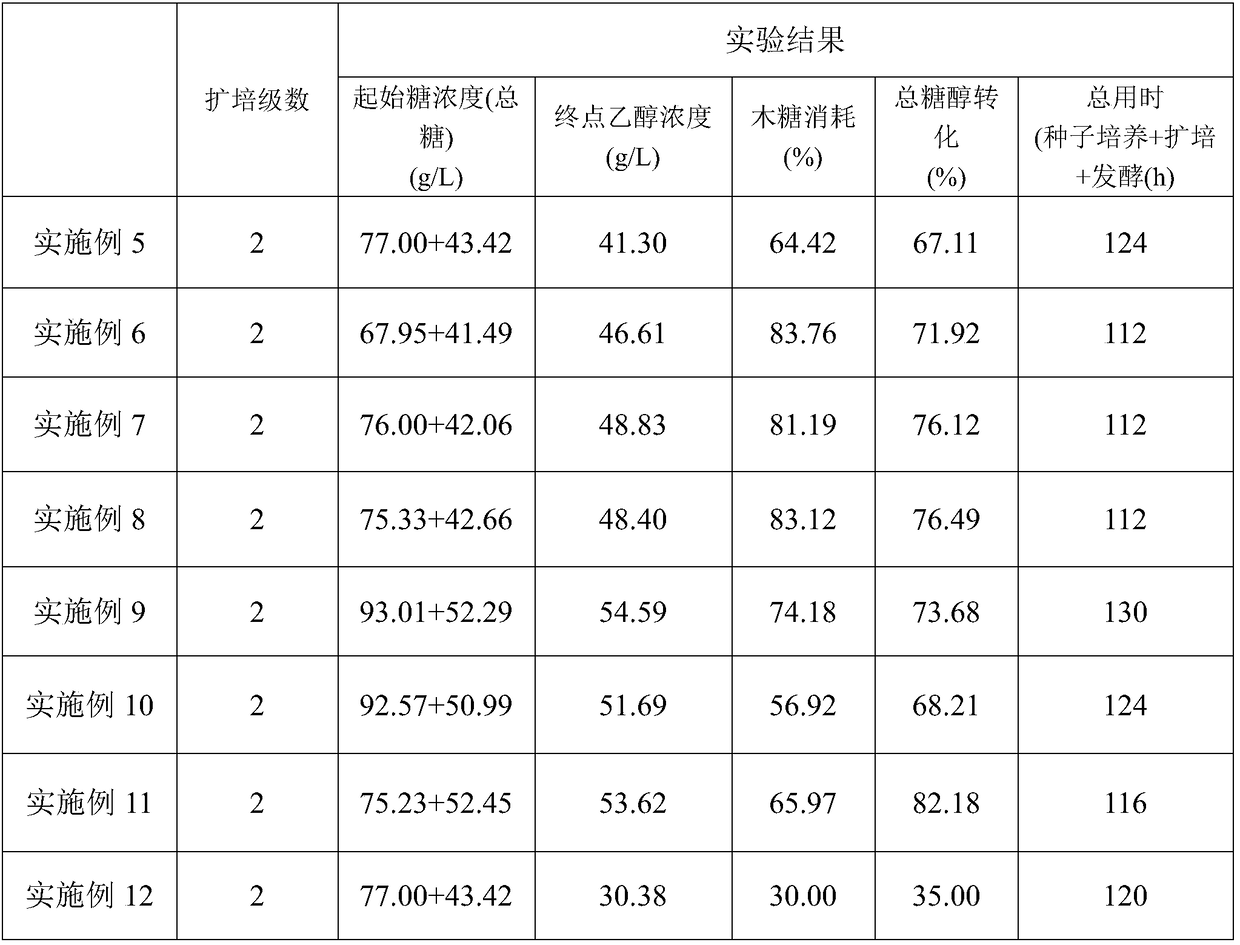A method for producing ethanol by using microorganisms to co-ferment C5 and C6
A microbial and co-fermentation technology, applied in the field of microbial fermentation, can solve the problem of low conversion rate
- Summary
- Abstract
- Description
- Claims
- Application Information
AI Technical Summary
Problems solved by technology
Method used
Image
Examples
Embodiment 1
[0080] This example provides an expanded culture method for co-fermenting C5 and C6 microorganisms to produce ethanol. The expanded culture experiment was carried out by taking recombinant S. ST) (such as Cellulosic ethanol production from AFEX-treated corn stoverusing Saccharomyces cerevisiae 424A (LNH-ST), M.W.Lau, B.E.Dale, Proc Natl AcadSci USA, 106(2009), pp.1368-1373; Two-step SSCF to convert AFEX-treated switchgrass to ethanol using commercial enzymes and Saccharomyces cerevisiae424A (LNH-ST), M.Jin, M.W.Lau, V.Balan, B.E.Dale, Bioresour Technol, 101(2010), pp.8171–8178 and other reports), for the city The expanded culture method adopts a first-level expanded culture step.
[0081] Specifically include:
[0082] A. Seed liquid culture steps
[0083] Prepare YEPD medium, inoculate the preserved above bacteria into YEPD medium, control the temperature at 25°C, pH 6.0, rotation speed 200rpm, ventilation rate 0.2L / L / min, and cultivate for 12h until the concentration of th...
Embodiment 2
[0089] This example provides an expanded culture method for microorganisms that co-ferment C5 and C6 to produce ethanol. Taking Candida tropicalis as an example to carry out the expanded culture experiment, the Candida tropicalis is commercially available, and the expanded culture Methods A two-stage expanded culture step was adopted.
[0090] Specifically include:
[0091] A. Seed liquid culture steps
[0092] Prepare YEPD medium, inoculate the preserved above bacteria into YEPD medium, control the temperature at 25°C, pH 6.0, rotation speed 200rpm, ventilation rate 0.2L / L / min, and cultivate until the concentration of the above bacteria is (0.1-0.5 )×10 9 a / mL;
[0093] The YEPD medium specifically contains 10 g / L of yeast powder, 20 g / L of peptone, and 20 g / L of glucose, and the pH is adjusted to 6.0.
[0094] B. Expand the cultivation steps
[0095] 1) Put the cultured seed solution into a 50L primary expansion tank containing a primary expansion medium according to th...
Embodiment 3
[0099]This embodiment provides a kind of expanded culture method of co-fermenting C5 and C6 to produce ethanol microorganisms, take recombinant S. Tertiary scale-up cultivation steps.
[0100] Specifically include:
[0101] A. Seed liquid culture steps
[0102] Prepare YEPD medium, inoculate the preserved above bacteria into YEPD medium, control the temperature at 30°C, pH 6.0, ventilation rate 0.2L / L / min, rotation speed 200rpm, and cultivate for 14h until the concentration of the above bacteria is (0.2 -0.3)×10 9 a / mL;
[0103] The YEPD medium specifically contains 10 g / L of yeast powder, 20 g / L of peptone, and 20 g / L of glucose, and the pH is adjusted to 6.5.
[0104] B. Expand the cultivation steps
[0105] 1) Put the cultured seed solution into a 50L primary expansion tank containing a primary expansion medium according to the inoculum amount of 10% (v / v), control the temperature at 30°C, pH 5.0, and rotate at 200rpm Ventilate the air, the ventilation rate is 0.5L / L / ...
PUM
 Login to View More
Login to View More Abstract
Description
Claims
Application Information
 Login to View More
Login to View More - R&D Engineer
- R&D Manager
- IP Professional
- Industry Leading Data Capabilities
- Powerful AI technology
- Patent DNA Extraction
Browse by: Latest US Patents, China's latest patents, Technical Efficacy Thesaurus, Application Domain, Technology Topic, Popular Technical Reports.
© 2024 PatSnap. All rights reserved.Legal|Privacy policy|Modern Slavery Act Transparency Statement|Sitemap|About US| Contact US: help@patsnap.com








